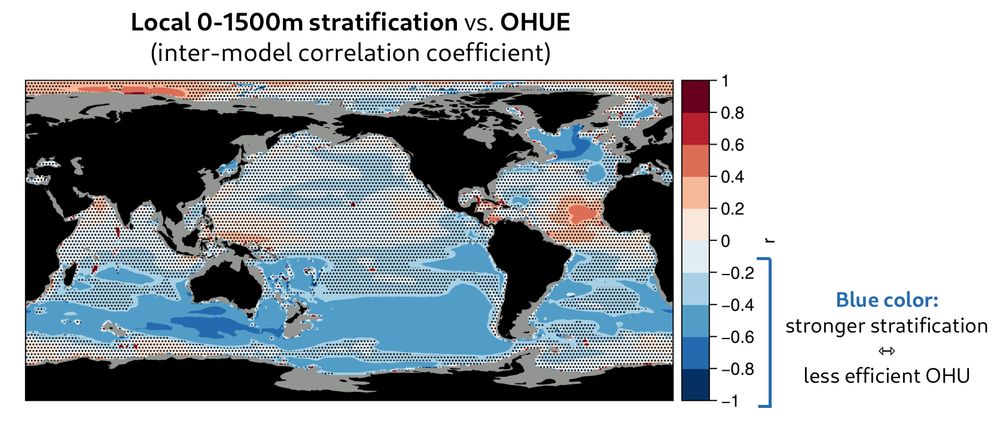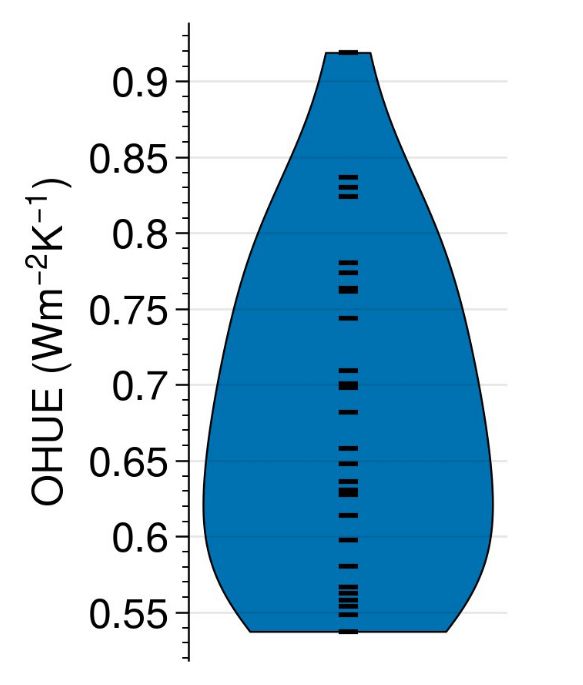Funnily enough, using HadISST in our study would also have led to an exaggerated "conservative" estimate of high warming, since then the models would underestimate Antarctic SIE even more. But fortunately we are not sailors.
Funnily enough, using HadISST in our study would also have led to an exaggerated "conservative" estimate of high warming, since then the models would underestimate Antarctic SIE even more. But fortunately we are not sailors.
- OHU +3–14%
- Cloud feedback +19–32%
- Global surface warming +6–7%

- OHU +3–14%
- Cloud feedback +19–32%
- Global surface warming +6–7%
More sea ice now → more warming later
This is evident as a strong correlation across CMIP6 models (and it also holds in CMIP5)

More sea ice now → more warming later
This is evident as a strong correlation across CMIP6 models (and it also holds in CMIP5)
Models with more sea ice today also simulate colder Southern Ocean SSTs, a colder deep ocean, and more mid-latitude cloud cover.
In the future, these models lose more sea ice and clouds, amplifying SW cloud feedback, surface warming, and OHU.

Models with more sea ice today also simulate colder Southern Ocean SSTs, a colder deep ocean, and more mid-latitude cloud cover.
In the future, these models lose more sea ice and clouds, amplifying SW cloud feedback, surface warming, and OHU.
Huge thanks to my (now former 🥲) PhD advisors, @jbsallee.bsky.social and Casimir de Lavergne!
Huge thanks to my (now former 🥲) PhD advisors, @jbsallee.bsky.social and Casimir de Lavergne!
As CMIP6 models are too stratified in precisely these regions on average, they tend to underestimate OHUE.

As CMIP6 models are too stratified in precisely these regions on average, they tend to underestimate OHUE.
This is because stratification in these regions is linked to large overturning cells: the Southern Ocean upper cell and the AMOC.

This is because stratification in these regions is linked to large overturning cells: the Southern Ocean upper cell and the AMOC.
Many answers have been previously proposed, including AMOC strength, mixed layer depths, and stratification.
In our paper, we use an ensemble of CMIP6 models to disentangle this issue.
Many answers have been previously proposed, including AMOC strength, mixed layer depths, and stratification.
In our paper, we use an ensemble of CMIP6 models to disentangle this issue.
However, current-generation climate models simulate a large range of values for this quantity, almost spanning a factor of 2:

However, current-generation climate models simulate a large range of values for this quantity, almost spanning a factor of 2:
This effect can be quantified by the "ocean heat uptake efficiency", the amount of heat uptake per degree of global warming.
OHU efficiency = OHU / ΔT
This effect can be quantified by the "ocean heat uptake efficiency", the amount of heat uptake per degree of global warming.
OHU efficiency = OHU / ΔT

